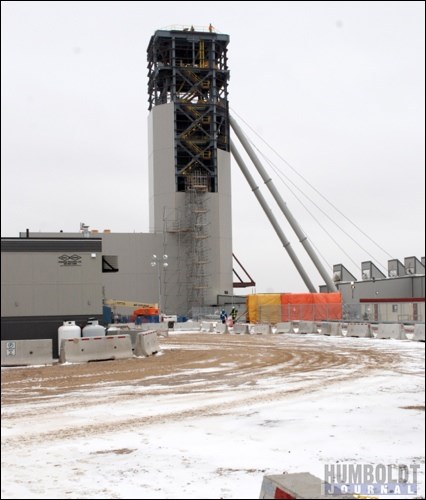They are using new technology on a new mine. During a media tour of the BHP Billiton Jansen potash mine site on October 29, the company showed off a new piece of equipment used to drill the mine shaft. The equipment, called a shaft boring roadheader, was built by a company in Germany, explained Tim Cutt, president of Diamonds and Speciality Product for BHP. "We erected it in Germany several months ago and conducted a test," said Cutt. "We cut a metre and a half down into concrete twice to test this equipment." Before the equipment could be installed at Jansen, BHP first had to dig a hole with conventional equipment, about 45 metres deep. "We are actually in the process now of taking parts of the equipment and lowering it in and re-erecting it in the shaft," said Cutt. This is a unique piece of equipment for a potash mine. "This is the first shaft to be excavated with this type of equipment," said Cutt. "It is a whole lot different than a typical type of manual cutting and buckets." This equipment, which is 40 metres tall when fully erected, will be put into the mineshaft for excavation. Once in, it will be suspended by four sinking winches. The road header's rotating grinder, which is outfitted with hundreds of cone -shaped instruments, will cut back and forth in the mine shaft through the soft and medium strength rock to break it up. "One of the most unique things about this is you are able to exploit mechanical excavation technology because the sedimentary rock that we are in is low to medium strength at best," said Gord Graham, project manager. He also pointed out this new technology is great because of the way the material is excavated. "The second thing we are able to take advantage of was because we are mechanically excavating it, it is producing small cuttings, rather than the larger ones you get from drilling and blasting," said Graham. Once the rock is cut, it will be vacuumed up. "It is a high velocity, low pressure vacuum system that is going to vacuum the cuttings up into two bunkers," said Graham. Those bunkers are located about 20 metres up from the bottom of the shaft. The material fills up two traditional sinking buckets, that are winched up."From that point on, it is very much like a normal shaft-sinking operation," said Graham. The equipment is also unique because it only requires four or five people working in the shaft. With traditional shaft excavation, there are generally a lot more workers in the shaft at one time. With this equipment, they should be able to excavate at the rate of three metres a day, said Cutt, although the Germans claim it can excavate at a rate of six metres a day. "There is a chance of getting down to the potash in a year," said Cutt. He explained they will start phase one of three phases to install the equipment in the mine shaft this week. Since it is so large, it will be installed in pieces, which will take a few weeks, but should be in by the end of November or December, when they can start excavating.

.png;w=120;h=80;mode=crop)

.png;w=120;h=80;mode=crop)
